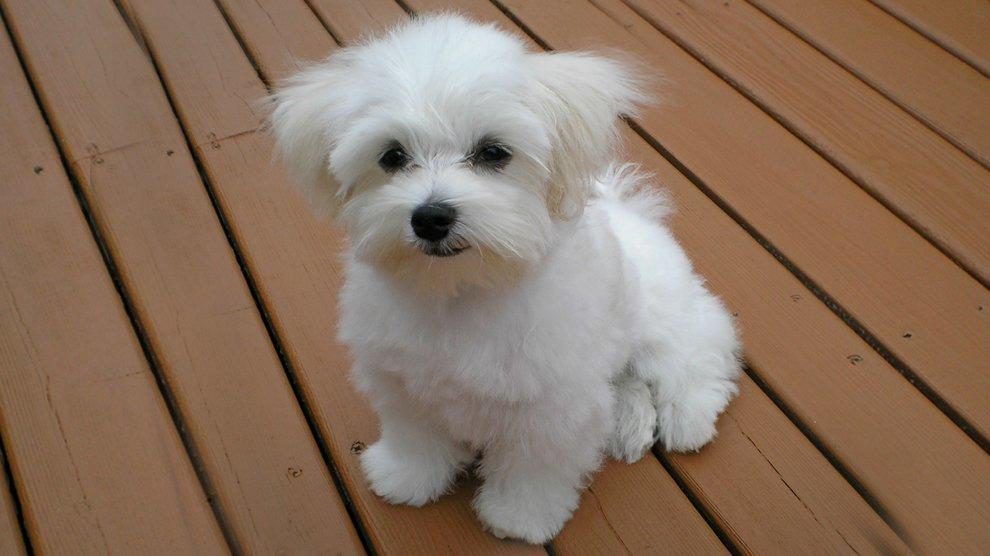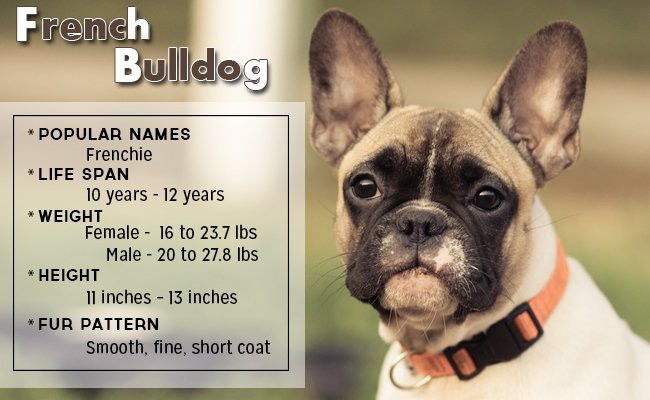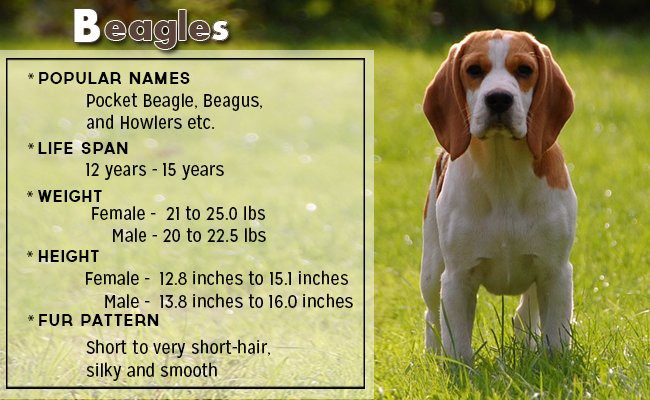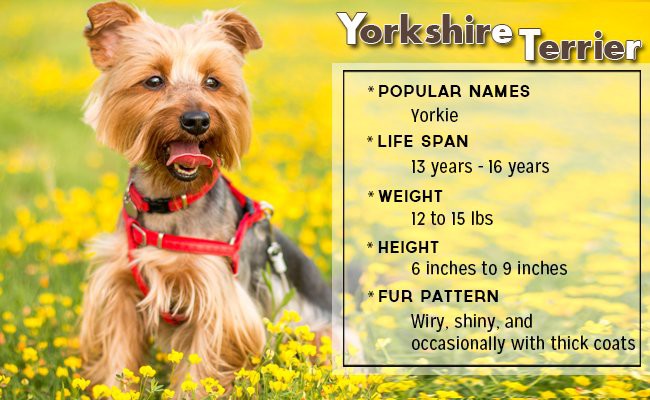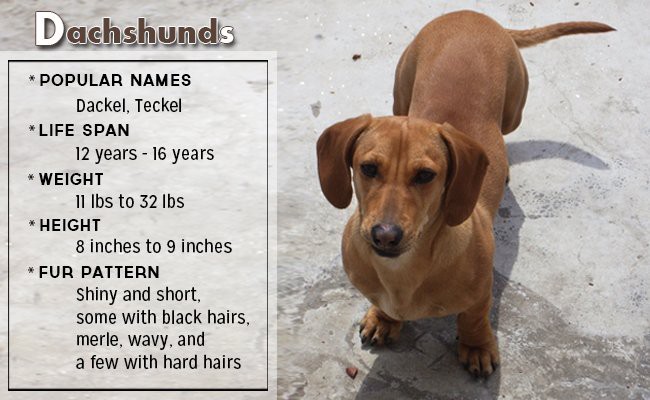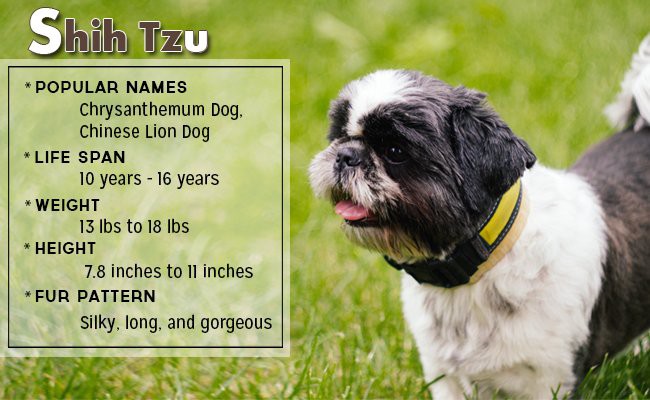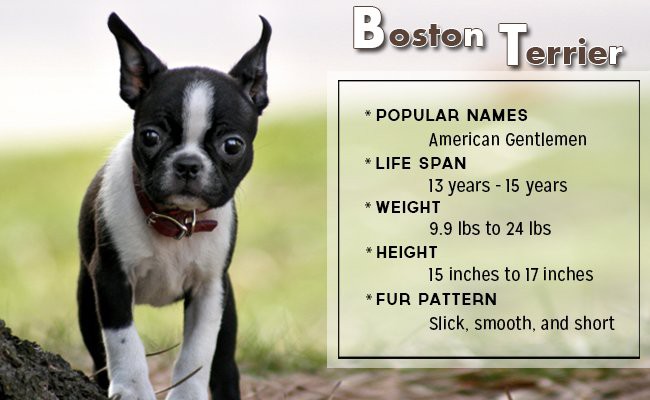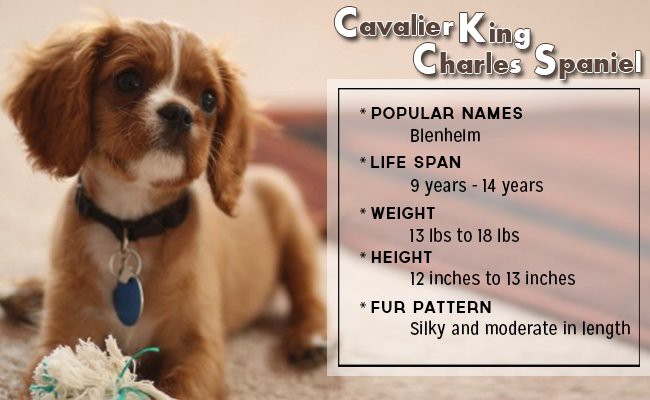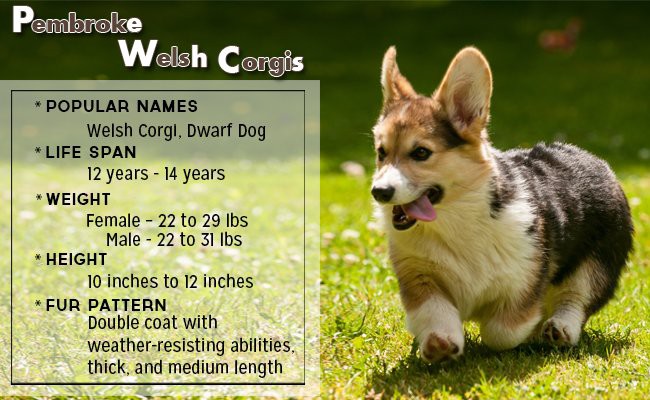- Small Dog Breeds Videos And Infographics
- French Bulldog - A Little Einstein
- Beagles - Comical And Cute
- Poodles - Elegantly Cute
- Yorkshire Terrier – A Bushy Companion
- Dachshunds - Brave and Lively
- Miniature Schnauzer – Owner’s Pride
- Shih Tzu – A Tibetan Magic
- Boston Terrier - The Gentlemen Dog
- Cavalier King Charles Spaniel – A Furry Toy Breed
- Pembroke Welsh Corgis – A Foxy Looking Dog
Dog Pregnancy Calculator And Timeline
If you are cramped for space, a wide array of exciting small-dog breeds are the best possible answer. On the whole, let’s read about the 10 most graceful, cute, and social small dog breeds.
Special Mention
The numbers of popular small breed dogs in America are vast and enormous. A few of them not included in the list but warrants special mention is – Miniature Pinscher, Scottish Terrier, Papillon, Bichon Frise, Shiba Inu, West Highland White Terrier, Maltese, Pugs, Chihuahuas, Cocker Spaniels, Shetland Sheepdog, Havanese, and Pomeranian.
French Bulldog - A Little Einstein
Key Points
- Popular Names – Frenchie
- Nativity –England and France
- Life Expectancy – They usually live between 10 – 12 years under normal healthy conditions.
- Weight –The Male French Bulldog weighs between 20 to 27.8 lbs. while females weigh between 16 to 23.7 lbs.
- Height –Between 28 to 33 cms
- Coat/Fur Pattern – These dogs have wrinkles and skin that appears loose and soft at the shoulders and head.
- Color – French Bulldogs, usually appear in various shades ranging from chocolate color, blue hue, red tan, cream, and white, etc.
- Grooming requirements –They require significantly less grooming. Cleaning their face with a white-damp cloth should be enough, and their coat needs little maintenance.
History
The first French Bulldog was introduced in England in the 19th century. However, in the 1860s, people migrated to France and also carried their dogs with them.
As a result, these cuties became quite famous in France, and this dog eventually entered England for dog exhibitions.
Appearance
They appear loyal and energetic in nature. Usually, Frenchies have muscular and lean builds. Other features include a medium frame, soft coat, heavy bone, intelligence, and activity.
Personality and Temperament
- French Bulldogs not only look attractive and relaxed; they hardly exceed growing beyond 1 foot vertically.
- In general, these dogs are not unduly in-obedient. They are playful, active, alert, and possess even disposition.
- Moreover, Frenchies are understandable, adaptable, and well-behaved dogs.
- Furthermore, they make an excellent family pet that likes and loves human warmth and affection.
- In essence, these are considered intelligent dogs with attitude and affection
Health Problems
Pannus – The condition wherein the cornea gets affected due to the extra growth of tissue is usually referred to as ‘Pannus.’ Other terms include ‘Cherry Eye’ meaning problem in the third eyelid area.
Corneal Ulcers – Normally, French Bulldogs, suffer from corneal ulcers when they are five years or more. They are mostly due to eye abrasions which occur because of a cat scratch or eye infections.
Megaesophagus – It’s not uncommon for Frenchies to get affected by esophageal conditions after eating or training.
Von Willebrand’s Disease – This disorder causes problems in blood clotting. Therefore, Von Willebrand’s Disease can lead to further serious complications.
Brachycephalic Airway Syndrome – Since these dogs have small airways and snout, avoid subjecting French Bulldogs to severe extreme temperatures. Furthermore, dogs can also suffer from respiratory disorders in the long run.
Training
Better start with puppy training classes and timely socialization as soon as possible. Taking the puppy along to different places will train the puppy to become a well-socialized dog.
Also, Frenchies need a fair amount of training. They can turn very adamant but generally remain very good at heart.
Exercise
These dogs enjoy the rally, agility, and obedience sports as such. Outdoor playtime with their partner should keep them in shape.
Caution – Do not train them in humid weather as they are genetically susceptible to breathing issues.
Nutrition (Foods for French bulldog)
Since this variety is easily susceptible to obesity, take note of their weight and food intake regularly. Avoid cooked bones and treat your dog with treats only in moderation.
To sum up, feed your dog with table scraps, only sparingly.
Beagles - Comical And Cute
Key Points
- Popular Names –Pocket Beagle, Beagles, Howlers, etc.
- Life Expectancy – Between -12 – 15 years
- Weight – The male beagles weigh between 21 to 25 lbs., and the females weigh are in the range of 20 to 22.5 lbs.
- Height – Male – around 35 to 40 cms; Female – 32.5 to 38.3 cms
- Coat/Fur Pattern – Short to very short-hair, silky and smooth
- Color – White and lemon, white and orange, white and brown, white and red, white and tan, Tri chocolate, and tri-color.
- Place of Origin – UK
- Grooming – Just trimming your beagle’s nails once a month is enough. They are easy to maintain and are no-fuss dogs.
Personality and Temperament
- The most active small dog breeds regularly found in America, Beagles, are a laugh riot to spend time with. Mostly funny, sweet, and gentle but frequently tend to misbehave without extra care and attention.
- Beagles are fond of their owners. They are absolutely people friendly, especially with family and kids who are ready to spend time.
- Popularly recognized as hound dogs, Beagles were grown for trail chasing and hunting.
- Being small in stature, these dogs enjoy close proximity to the ground, giving them sound overall balance. These dogs can easily detect other animals or humans from a distance due to their unique scent receptors. Moreover, beagles have ears that can distinguish various types of scent.
- Known as a vocal dog, they raise three different types of noises.
They are
- Normal barks
- “Bay” bark that signals that they are behind a scent
- “Ole” barks that indicate beagles are tired and done.
Therefore, a faithful companion for every home, the Beagles are a joyous lot if their cute, eccentric behavior is overlooked.
History
Beagles are famous since the 16th century. They can also track animals, including quails, pheasant, hare, and rabbits. As per reports, “be’ geule” means “hard throat” in French, which could be why they were named beagles. In general, Beagles have a baying voice.
They are also famous for their detection skills, which make them the first choice in drug-detection squads.
Appearance
In appearance, a hardcore mini Foxhound, beagles are sturdy and healthy, featuring the look and feel of a hound. Overall, beagles are healthy enough to chase and catch his prey without giving up.
Health
- Polygenic arthritis – This condition sets in when the immune system suffers a breakdown, thereby causing pain and stiffness. The symptoms of polygenic arthritis are lethargic movements, lack of mobility, and limping.
- Pannus – Pannus can affect your beagle if you fail to pay enough attention when they stumble across the house quite often.
- Intervertebral disk disorder – When the disc collapses (between vertebras) in your dog, causing leaking and swelling, this is known as intervertebral disk condition. Known signs are the inability to eat, limping, shivering, behavior, and inactivity.
- Hypothyroidism – Common signs of hypothyroidism are ear infections, hair loss, dry skin, and exceptional weight gain. This condition sets in when glands fail to produce adequate thyroid.
- Epilepsy – Although recurrent seizures are relatively uncommon in beagles still they can be treated with medications.
Training
Like other dog breeds, frequent puppy training and very early socialization are advised. In fact, beagles fail to act under strict masters, but constant positive motivation will provide the much-needed results.
Exercise
They need at least 1 hour of exercise daily. Bear in mind, beagles work in packs. So, never allow or leave your beagle alone for too long. Moreover, beagles are brilliant escape dogs. Therefore, proper fencing that extends underground is recommended.
Take them on walks only on a leash since they can easily get carried away by strong scents.
Nutrition
Being active dogs, beagles need a very rich-protein filled diet. Therefore, choose a diet that includes meat, fish, and poultry. Not to mention, fish oil, sunflower oil can keep your beagle’s coat healthy and shiny.
Poodles - Elegantly Cute
History
The French adore their poodles, and they are called “duck dog” or Caniche. Declared as France’s national dog, the poodles, however, originated in Germany.
Miniature and Standard varieties captured the imagination of the masses with ease. Moreover, their brilliant sniffing skills gained them additional responsibility as truffle chasers.
Appearance
A dog that carries himself elegantly, poodles are well-proportioned and are very smart.
If properly maintained and groomed, they can display a very deceptive arrogance and pride in their walk and behavior.
Key Points
- Popular Names – Caniche Pudelhund, Sleeves
- Life Span – Between 12 & 15 years
- Weight
- Standard Poodle – Male – 45 – 72 lbs; Female – 45 to 62 lbs
- Mini Poodle – 15 to 18 lbs; Toy Poodle- 6 – 9 lbs
- Height
- Standard Poodle – 38 cms to 58 cms
- Mini Poodle – 27.9 cms – 38 cms; Toy Poodle –25.4 cms(max)
- Coat/Fur Pattern – Dense, wiry, and curly hair
- Colour – Cream, Apricot, Brown, Silver, Gray, White, Black, and Blue, etc.
- Place of Origin – Germany
- Grooming – Learn to brush your poodle. Else the hair might mat and will need a total shave to get new growth.
Personality and Temperament
- Elegant and classy, poodles are good at hunting waterfowl. Originally from Germany, the Poodles later made it big in France.
- Standard ones were trained for dog hunting, while toy poodles and mini poodles were known to provide the rich and wealthy company.
- Known for their circus skills, these dogs can perform a wide variety of tricks if trained professionally.
- They love to jump around and have fun; Poodles are people-friendly in nature. With inborn intelligence, this combination is a rare find in any dog.
- Mischievous, loyal, loving, and intelligent; Poodles have their own air of attitude, easy to identify but difficult to pinpoint.
- Well trained poodles can behave very gently and softly.
- They are very secure but will take some time to move along with unknown persons.
All in all, Poodles are positively brilliant small dog breeds whose intelligence can even stun their owners.

Health
- Skin allergies –They are very susceptible to excessive hair loss, rashes, and skin allergies. Take them to a vet if you notice discomfort and scratching.
- Volvulus and gastric dilatation – The dog’s stomach gets affected, and it’s filled with liquid and gas. On the other hand, volvulus indicates stomach twisting.
Symptoms include severe issues like peritonitis, perforation, and also dehydration. Also, watch out for signs like moaning when the poodle’s stomach is touched. - Epilepsy – Take your dog immediately to the nearby vet if you notice seizure or epilepsy since they can be quite severe in some cases.
Training
Bear in mind, toy poodles are known for their easy-going behavior and approach. Poodles, in general, are smart and agile and they also love taking part in canine sports. They are adorable at hunting games and dock diving.
Since poodles are family dogs, be positive and consistent with your expectation and training.
Exercise
These dogs love to stay active, and almost all poodles love swimming. Natively bred as retrieval dogs, they are very natural at retrieval events such as tossing sticks and balls.
Overall, poodles love long walks and jog with human companions.
Nutrition
Use canned items only occasionally and serve them a protein-rich diet. Ensure that they are served with a new food item so that they won’t get bored quickly.
Yorkshire Terrier – A Bushy Companion
Key Points
- Popular Names – Yorkie
- Life Span – Between 13 to 16 years
- Weight – Normally between 12 & 15 lbs
- Height – Around 15.2 cms to 23 cms
- Coat/Fur Pattern – Wiry, shiny, and occasionally with thick coats
- Color – Light Blue to Standard Blue, Tan, Cream, White and Black, and Brown etc.
- Place of Origin – Yorkshire (England)
Personality and Temperament
- Originally from England, Yorkies can hunt vermin and rats effortlessly. Their hunting skills are world-renowned.
- In general, attention-seeking Yorkies always look for companions.
- Known as space-friendly dogs, Yorkshire Terriers make brilliant companions even in space-starved homes.
- Yorkies gel well with known pets and people; they usually avoid mingling with strangers.
- Yorkshire terriers are born with natural guarding skills.
- Overall, Yorkies are very friendly and happy to stay with humans.
History
Initially, Yorkies were developed in Lancashire and Yorkshire in the 19th century. Meanwhile, in the late 18th century, the English Kennel Club gave them recognition. With this freshly generated publicity, the Yorkshire terriers have turned themselves into a luxurious lap dog.
America’s first recorded Yorkie was called Belle, a female Yorkshire terrier in 1885.
Appearance
The dog looks well distributed, compact, and neat. Furthermore, Yorkie’s confident behavior and high head carriage reflect the dog’s self-importance and vigor.
Health
- Reverse sneezing – Reverse sneezing and collapsed trachea might appear one and the same but reverse sneezing is not as severe as the latter.
This condition occurs only when your Yorkie gulps or munches food too fast. Immediate treatment includes slightly stroking your Yorkie’s throat, and your dog should be fine in a couple of minutes. - Collapsed Trachea – When the passage that transports oxygen to the lungs collapses, it results in a goose honk type bark. Medication and surgery are the two most accessible solutions.
- Hypoglycaemia – Signs of low sugar involve seizure, abnormal gait, lack of concentration, and weakness.
- Portosystemic Shunts – In this condition, the blood supply gets disrupted by the dog’s liver and other parts. Moreover, this condition can turn fatal since the liver manages metabolism and detoxing.
Some common signs are stunted development, resistance to medication, urinary condition, loss of appetite, etc. - Progressive Retinal Atrophy – The gradual deterioration (retina) can cause night blindness and eventually full blindness. Above all, there are no solutions, but dogs typically manage to lead a peaceful life.
- Patellar Luxation – A disorder where the kneecaps are not placed, causing excessive pain and lethargy in dogs. The much-needed treatment for patellar luxation is surgery.
Training
In general, Yorkies are owner friendly dogs. Giving treats and appreciation will work wonders with them. Furthermore, from a very early age, Yorkies need socialization training. Despite their small appearance, Yorkshire Terriers are good at obedience and other canine games.
They are also excellent at therapy activities.
Exercise
Smart exercises such as steady walk in the backyard or making them run behind a football are good energy boosters.
Nutrition
Regional foods can include veggies like potatoes and beets along with fresh meat such as lamb etc. If your dog is new to fresh beef, feed him only a little and watch his progress.
Finally, add healthy oils, vegetables, and meats to their diet.
Dachshunds - Brave and Lively
Key Points
- Popular Names – Dackel, Teckel
- Life Span – Between12 to 16 years
- Weight – 11 to 32 lbs
- Height – Around 20.3 cms to 22.86 cms
- Coat/Fur Pattern – Shiny and short; some with black hairs, merle, wavy, and a few with hard hairs
- Colour – Cream or red, tan, brindle, wild boar, Isabella, grey, and chocolate to name a few
- Place of Origin – Germany
- Grooming – Trim the nails regularly, check their ears for debris and wax, and brush their teeth regularly.
Personality and Temperament
- Lively and exciting, the Dachshund and Terrier have quite similar personality traits, attention-seeking behavior.
- A bright, alert, active dog by birth, they are too fast to react at every unfamiliar sound and sight; dachshunds need constant supervision.
- Born as free-spirited dogs, they are very subtly deceptive at times. All in all, these dogs require enough training and practice to suit their lifestyle.
- Very adamant by nature and their unique natural instincts to hunt and chase birds, chipmunks, etc. need to be supervised every now and then.
- Housebreaking and dachshunds are not made for each other.
- Moreover, digging holes is a common sight of a Dachshund’s presence.
- Dachshunds consisting of short hairs are very cautious of their surroundings.
- Longhaired Dachshunds are known for their charming and quiet behavior. In fact, Wirehaired Dachshunds are more obstinate and mischievous.
History
Known as “badger dog” in German, they are more than 600 years old. In fact, Dachshunds were bred to hunt badger, and they had sharp claws and teeth.
Overall, the strength, perseverance, courage, and cleverness visible in this dog were bred into this dog from the beginning itself.
Appearance
Dachshunds are generally robust with short legs, an elongated body, and low in height. Looking neither cramped nor crippled for movement, this is an alert, bright, and confident dog.
This dog also carries a very unique build, loud tongue, and a perfect nose. Therefore, dachshunds are considered suitable for trails.
Health
- Deafness – They are known to suffer from hearing deficiency. Moreover, deafness might not appear until old age, but Dachshunds born with hearing loss are not uncommon.
- Bloat – Being good eaters, Dachshunds are affected by this condition when they eat and drink very quickly or become insanely excited.
The gas builds up in the stomach, and your Dachshund might feel irritated and annoyed. Do not take bloating lightly. - Epilepsy – Seizures are treated well with medications, and they can range from mild to harsh depending upon your dog’s ancestry.
- PRA or Progressive Retinal Atrophy – The dog might suffer from total blindness in one eye or in both eyes when the condition worsens.
There are no available cures for PRA, and only lifestyle changes can save your dog.
Training
Dachshunds are not so easy to train. They are smart and intelligent. With positive training and rewards, Dachshunds respond well.
For strict commands, do not expect your Dachshund to behave obediently. So, you stay as consistent and patient as possible.
Born with excellent sensing abilities, they cannot be easily dislodged when they are on their sensing trail.
Exercise
Most owners miscalculate that Dachshunds need very minimum or no exercise as they are small in appearance. However, without proper training, Dachshunds will suffer from weak back and muscle strength.
Two moderate walks daily are enough to turn your Dachshund into healthy and treat them with care. Being very social by birth, they prefer to remain indoors only.
Nutrition
Make sure that your Dachshunds are not overweight. This will not only improve the dog’s overall health but also keeps the back healthy. Obese Dachshunds are known to suffer from herniated or slipped discs.
Please store food in a place where your little master cannot reach and avoid high fats and cooked bones totally. Overall, feed him doctor recommended or trainer advised diets.
Miniature Schnauzer – Owner’s Pride
History
As a matter of fact, Schnauzer consists of a lineage dating back to the 15th -16th century. The German farmers later bred the regular Schnauzer to a less small looking variety called Miniature Schnauzers.
The dogs were bred to work tirelessly as active barnyard ratters. However, at present, they are known for their attractive and charming personality.
Appearance
Belonging to the terrier type, these dogs are enthusiastic and robust. Even though they resemble their older cousin, Miniature Schnauzer possesses an active and alert character.
Key Points
- Popular Names – Dwarf Schnauzer
- Life Span – Between 12 to 14 years
- Weight – Male – 12 to 20 lbs; Female – 12 to 18 lbs
- Height – Male – 30.4 cms to 35 cms; Female- 30.4 cms to 35 cms
- Coat/Fur Pattern – Double coat with wiry and hard outer coat and soft and close undercoat.
- Colour – Pitch black, silver and black, pepper and salt
- Place of Origin – Germany
- Grooming – Keeping the coat as clean as possible and hiring a groomer every 40 to 45 days is recommended. Check your dog’s ears and nails as regularly as possible, and a bath every 30 days is advised.
Personality and Temperament
- Miniature Schnauzer shines through due to their rich ancestry; terrier heritage.
- Known for their protective instincts, they are famous for their appearance, whisker-like hairs.
- Miniature Schnauzers are a right cross between a Standard Schnauzer, Affenpinscher, and a Poodle.
- In general, they behave well as watchdogs and do justice with their bark rather than their bite.
- Very strong and active, they compete in different ball tracking activities such as dog tracking, fly ball, showmanship, and obedience.
- With their in-born hunting instincts, they attack their opponents even without provocation.
- Overall, Miniature Schnauzer is respected for their eagerness to please, their intelligence, spirited and alert nature, the timid or never overaggressive behavior.

Health
- Congenital Megaesophagus – A dog having congenital megaesophagus will carry pneumonia and thereby suffer from esophagus damage. The best possible treatment includes changing the diet as per requirement.
- Von Willebrand’s Disease – This condition results in issues related to the clotting of blood. In the case of trauma or surgery, blood clot failure can cause untold problems.
- Myotonia Congenita – They are not similar to muscular dystrophy. Symptoms include stiff coats, hopping instead of running, thigh, and muscular problems.
- Bladder Stones – Dogs suffering from bladder stone trouble will experience cloudy urine, bloody urine, or pain while passing urine. In general, small stones will leave the body via urine, but a vet opinion is recommended in any case.
- Entropion – Entropion happens when the dog deals with irritation and vision loss caused due to various reasons. If a dog has been diagnosed with Entropion, gather professional advice before proceeding further.
- Cataracts – Cataracts can only be removed with surgery and canine cataract refers to severe vision impairment.
Training
These dogs learn as quickly as possible and are lively and friendly by nature. However, this breed gets bored quite quickly, and new activities are advised every now and then.
Overall, Miniature Schnauzer performs handsomely well in earth dog activities, rally, obedience, and agility.
Exercise
Lively and smart, these dogs need daily activities to remain physically and mentally active. They quickly adapt to country or city living.
Nutrition
Avoid foods that contain artificial preservatives such as Gallic acid and propyl gallate. Also, ensure that your dog feeds only on a rich diet filled with protein. Moreover, select only those food items that are free of dyes and chemicals.
Shih Tzu – A Tibetan Magic
Key Points
- Popular Names – Chrysanthemum Dog, Chinese Lion Dog
- Life Span – 10 to 16 years
- Weight – Male – 13 to 18 lbs; Female – 13 to 18 lbs
- Height – Male – 19.8 cms to 27 cms; Female- 19.8 cms to 27 cms
- Coat/Fur Pattern – Silky, long, and gorgeous
- Colour – Dark Brown, Gold, Light Brown, Black and White, White and Liver, Blue, Liver, Brindle, White, and Black.
- Place of Origin – Tibet, China
- Grooming – They require very high maintenance. Regular grooming is necessary to keep your dog’s coat soft and shiny.
Personality and Temperament
- A lovely, friendly companion; Shi Tzu can be described as a thrilled house dog keen to impress people with its antics.
- Shi Tzu’s are not known for their retrieving, guarding, or hunting skills but for their intimate and never-ending love for their owners.
- Lively and alert, being couch-potato is not their style.
- Shi Tzu is good with children, but with toddlers, they are known for their troubling behavior.
- They need coolers or air conditioners to manage their body temperature as they are prone to heat strokes.
- Dental problems are not uncommon with Shih Tzus, and sometimes they might snore and wheeze like humans.
All in all, Shi Tzu’s appear enormously graceful, beautiful, and excellent partners to bring home.
History
Remember, Shih Tzus carry royal air with them. Royal Chinese breeders developed a dog called Shih Tzu (lion dog) by crossing Pekingese and Lhaso Apso.
However, this breed remained unknown for centuries until the early 20th century. Breed clubs in England and Peking started competing with each other fiercely and produced remarkable dogs.
Such is the charm of Shih Tzus that even the likes of Miley Cyrus and Queen Elizabeth II own this dog breed.
Appearance
With a long shiny double coat, Shih Tzu is a lively and sturdy dog. Doing full justice to his royal roots, Shih Tzus carries an arrogant and distinctive posture.
To sum up, royal dogs for those who love to taste royalty in every stride.
Health
- Portosystemic Liver Trouble – This condition happens when the blood supply to the dog’s liver gets stunted or bypassed, thereby damaging the liver.
In most cases, this happens due to birth abnormalities, and common signs include stunted development and reduced muscle growth.
Shih Tzus suffering from disorientation might also suffer from Portosystemic liver disorder. - Hip Dysplasia – Results in lameness due to hip deformities and other hip-related problems.
- Brachycephalic Airway Disorder – In general, all dogs are prone to this disorder, but small dog breeds like Shih Tzus are more prone. Hot and humid weather conditions can actually accelerate this brachycephalic airway disorder.
- Intervertebral Disk Disorder (IDD) – When the disc located between the vertebrae is affected, causing leaking and swelling, IDD is said to occur. Common signs are difficulty in eating, limping, shivering, and lethargic behavior.
- Hypothyroidism – Inflammation can cause this problem, and some signs include ear trouble, dry coat or skin, and irrational weight gain.
Training
Yes, training this dog can be, at times, frustrating as well as amusing. Being a royal breed, These Tzus charm their masters with their love oozing eyes, thereby becoming challenging to train them as house pets.
They are simple people, friendly dogs, and rewards and praise work here. Avoid strict training and adopt a consistent training schedule and remain firm when you notice bad behavior.
If you see a Shih Tzu jumping or nipping unnecessarily, stay calm and pay no attention until he behaves obediently. So, enroll or engage them in classes that focus on a reward-based approach and not something else.
Exercise
They were initially grown as house pets only. Minimum exercise is enough, and regular short walks and indoor activities are sufficient to keep this dog happy.
Nutrition
Watch their food intake as they have the tendency to gain weight. Consult your breeder or your vet to decide the best possible diet for your Shih Tzu.
It’s better if you select foods that contain barley, oats, and sweet potatoes and those with more lean proteins. For example, – eggs, turkey meal, turkey, and chicken items are suggested. In fact, they also like dry foods.
Boston Terrier - The Gentlemen Dog
Key Points
- Popular Names – American Gentlemen
- Life Span – Between 13 to 15 years
- Weight – Between 9 – 24 lbs
- Height – 38.1 cms to 43 cms
- Coat pattern– Slick, smooth, and short
- Color – Different colors ranging from Brindle to Seal.
- Place of Origin – The United States
- Grooming – Remove loose hair and brush your dog’s coat at least once a week. Furthermore, brushing induces new hair development, and trimming the nails will reduce problems while running and walking.
Personality and Temperament
- Even though they are related to fighter dogs and a Pitbull, they exhibit a calm sense of character.
- Due to their small stature, they are aptly suitable for apartments.
- “The American Gentlemen,” Boston terrier’s memorable sobriquet.
- When they feel intimidated or threatened these dogs never fail to show their wrong aggressive side.
- However, uniform training and practice can definitely keep your Terrier under control.
Overall, they are a very soft and gentle dog, which makes them the best companion dog.
History
In England, in the late 19th century, a stable cross between English Terrier and Bulldog gave birth to a dog called Judge.
Later, Judge became the common parent of every Boston dog. Moreover, as days rolled by, the breed was now called the Boston Terrier. Overall, Boston Terrier holds the reputation of being a Massachusetts official dog since 1979.
Appearance
Boston terriers are well-proportioned, compactly built, highly smart, lively dogs. This dog contains a head proportional to its size and displays a high level of intelligence.
The body appears well-knit and short, the limbs look neat and strongly built, and the tail is mostly straightforward. Therefore, the dog signals grace, activity, and strength.
Health
- Cherry Eye – A matter related to cosmetic abnormality, a condition where the dog’s eyelid prolapses completely. Cherry eyes appear, as per reports, due to genetic factors.
- Patellar Luxation – Also referred to as “Knee dislocation,” this condition might affect your dog too. In case if you notice your dog limping or whining in pain, then it’s high time you take him to a vet.
- Heart Murmurs – Heart murmurs are usually referred to as the state wherein your pup suffers from too loud or too soft heartbeats. Vets treat this disorder with diuretics, a new diet, medication, and exercise.
- Megaesophagus – If you somehow find your dog regurgitating his food, then contact your vet as soon as possible.
- Reverse Sneezing – The nasal secretions block the dog’s windpipe and you may see your dog making odd wheezing sounds. To sum up, Boston terriers are known to suffer from this condition anytime in their lifetime.
- Allergies – The most popular allergies that can affect your dog are itchy skin and severe hair loss. In general, it ideally depends on your dog’s immune system.
- Hip Dysplasia – A dog is said to suffer from this condition when its thigh bone and hip joint are not in position. Common signs include lameness, and your dog may sound lethargic.
Training
Treats and positive training make the right combination. To sum up, gentle and soft corrections can be made with praise and warm gestures. Most Bostons are very sensitive to harsh training.
Exercise
It varies from one dog to another, and some will need more exercise, like walking twice. Other Bostons can do better with everyday playtime itself. But, these dogs do not like to be left alone and will display objectionable behavior.
Taking part in the rally, fly ball, and other canine sports activities are also better for these Bostons.
Food
Generally speaking, the Boston terriers should be fed with high-quality, homemade, or commercially prepared foods. Any diet schedule you follow must suit your dog.
Cavalier King Charles Spaniel – A Furry Toy Breed
Key Points
- Popular Names – Blenheim
- Life Span – Between 09 to 14 years
- Weight – Male and female both weight between 13 to 18 lbs
- Height – Male and Female- 27.9 cms to 33.02 cms
- Coat/Fur Pattern – Soft and medium in measurement
- Color – Blenheim, Ruby, Tri-color, Black & Tan
- Place of Origin – UK
- Grooming – This dog contains a silky, lustrous coat that needs more than ordinary brushing. With brushing, the dog’s coat remains clean and shiny. The ears must be checked for any infections, and nails must be trimmed every 30 days.
Personality and Temperament
- This dog loves people and only people. So, they will do everything under their belt to please their owners.
- Happy to remain amongst the crowd, Cavalier King Charles Spaniel will become the cynosure of everybody’s eyes.
- Cavalier King Charles Spaniel loves food, and they must be checked for overeating without fail.
- They possess qualities such as delightfulness, cheerfulness, and astute. These dogs are always loyal to their owners.
- Not known as kennel dogs, people prefer them as an excellent friendly dog.
- Cavalier Spaniels are good with kids and cats.
Therefore, these dogs are relatively easy to maintain and train and behave playfully by barking joyfully.
History
Toy spaniels or Cavalier spaniels still remain the most wanted dog of the British monarch since the 19th century. At that time, the Marlborough family developed a new white and red variety.
Later, this breed was then crossed with Japanese Chin and Pugs and became known as Charles Spaniel and English Spaniel in the UK and America.
The breed became famous for different color patterns such as
- Ruby ( Bright red)
- Tan and Black
- Tricolor
- Blenheim
Appearance
Affectionate and gentle, sporting, and fearless in character, very free in motion, Cavalier Charles is a graceful and active dog.
The breed’s main trait includes a royal appeal, real elegance, and gay temperament. Overall, a natural look with no notable artificial alteration, sculpting, or trimming is necessary.
Health
- Keratoconjunctivitis Sicca –This condition targets and affects the dog’s tear glands, gradually reducing tears’ production. Watch out for irritated or tired eyes.
- Patellar Luxation –A condition where the Cavalier Spaniel suffers from kneecap dislocation. In reality, lameness and difficulty in walking are common signs.
- Hip Dysplasia –A prolonged condition that often leads to immobility and, moreover, hip dysplasia is due to genetic deformity.
- Syringomyelia –In this case, the skull and brain are not in the correct proportion, causing significant discomfort and pain.
- Mitral Valve Disease (MVD) –MVD starts with a mild heart murmur and later turns into severe abnormalities until the dog suffers complications like a heart attack.
Finally, Cavalier Kings are affected by this disorder quite early in their lives and not like other breeds.
Training
The Charles King is a kind, gentle, and soft breed, known to attract humans with their behavior. In fact, these dogs are exceptionally social with children and other animals.
Cavaliers get trained efficiently and do great in several activities such as agility, rally, and obedience. Due to their pleasing personality, they are good therapy dogs.
Likewise, with all other breeds, Spaniels need puppy training as well as socialization classes.
Exercise
Even though Cavalier Spaniels are grown as a lap dog, he is genetically in favor of outdoor activities and moderate exercises.
A happy fenced yard is advised, and Cavalier Spaniels should always be on the leash because they retain inbuilt hunting and scenting skills. Overall, Cavalier Spaniels will remain delighted to stay at home.
Nutrition
The main components that should become part of your dog’s diet include
- Beneficial things like super green foods, digestive enzymes, and probiotics.
- Self-made mineral and vitamin mix
- Fruit and veggie puree
- Organs like the liver etc.
Best diet combinations are 12 percent of vegetable parts and 88 percent with bones, organs, and meat.
Pembroke Welsh Corgis – A Foxy Looking Dog
Key Points
- Popular Names – Welsh Corgi, Dwarf Dog
- Life Span – Between 12 to 14 years
- Weight – Male and females are between 30 lbs and 28 lbs respectively
- Height – Female Pembrokes and male Pembrokes are between 25 to 30 cms
- Coat/Fur Pattern – Double coat with weather-resisting abilities, thick, and medium length
- Color – Sable, blue, red, white and black, tan and black, and fawn.
- Place of Origin – Wales, UK
- Grooming – This dog has a coarse outer coat and light, soft undercoat. The breed suffers from shedding in early summer or late spring. A regular combing session will ensure that the shedding is kept as minimal as possible.
Treat them with regular baths as instructed by the breeder and use a rake to clean the undercoat.
Personality and Temperament
- Both the varieties of Corgi, Cardigans and Pembroke Welsh Corgi carry the same genes; some of the mix breeds like the Corgi Husky Mix are also found to possess similar traits. They are from a spitz dog (Northern).
- Pembroke Welsh corgis are known for their docked tails while Cardiganscarry long tails.
- These dogs have natural skills for doing activities such as livestock, managing cattle, and herding.
- Pembroke Welsh Corgis are very happy, affectionate, and loving dogs. They are seldom subservient, and you can generally find them independent and stubborn.
- Without proper socialization skills, Pembroke puppies will find it difficult to mature into good adult dogs.
- They are not only vigilant dogs, but Pembroke’s are also agile and fast.
In conclusion, Pembroke Welsh Corgis are cute little family dogs that can become even more obedient with proper and continuous training.
History
In those times, Northern Belgium in Europe hosted the best weavers in the town. On an invitation from Henry I, some weavers moved to Wales. With them, they carried many things, including their pet dogs. Later, these pets were identified as Pembroke Welsh Corgi.
Since 1933, Britain’s royal family has owned a Pembroke Welsh Corgi to date.
Appearance
Pembrokes are never unruly or shy. These dogs are kind and bold. They have short heavy bones and do not look racy or overdone.
Consisting of good stamina, they sustain an image of substance coupled with the active and sturdily built body.
Health
- Von Willebrand’s Disease (VWD) – A dog with von Willebrand’s disorder will suffer from bleeding gums, nosebleeds, and in general, blood clot issues. Pembrokes suffering from this disorder can lead to a near everyday life, and at present, there are no available cures for VWD.
- Retinal Dysplasia – Retinal dysplasia can cause blindness, and in some cases, the detachment of the retina may occur due to excessive retinal growth.
- Progressive Retinal Atrophy (PRA) – In PRA, Pembroke will undergo retinal deterioration, and some dogs lose their night vision. However, dogs can adapt to the new defect with ease as long as they stay in the same environment.
- Pulmonary Hypertension and PDA (Patent Ductus Arteriosus) – Pulmonary Hypertension means substantial-high blood pressure affecting the lungs. When the non-oxygenated blood misses the lungs, PDA is said to occur.
Only surgery is the known solution as of date. - Degenerative Myelopathy – This disorder mainly affects the very agile German Shepherds, but Pembrokes also suffers from this disorder.
Not to mention, the typical signs include difficulty in standing, losing the capacity to walk, slipping rear limbs, and dragging feet. At present, there are DNA tests to identify this disorder, and the affected should not be bred. - Cystinuria – Cystinuria mainly affects the male Pembroke, a problem where the cysteine protein is discharged via urine.
- Cutaneous Asthenia – The dog’s skin becomes stretchy, fragile, and loose. Cutaneous asthenia leads to blood blisters and bruises.
Training
Gently engaging the puppy in a different set of situations, places, and people between 7 weeks and 4 months is highly recommended.
Moreover, Pembrokes often behave strangely but respond well to reward-based positive training.
Exercise
An athletic dog created to handle livestock and cattle; the Pembroke likes the physical job and is happy to do these tasks.
They benefit from moderate to light physical exercises to maintain mental and physical health. Also, most Pembrokes love and take part in tracking, obedience, and herding events.
Nutrition
In general, Pembrokes are susceptible to obesity. So, kindly monitor their food intakes closely. Feed your pet at least twice daily, and avoid stacking food all the time.

